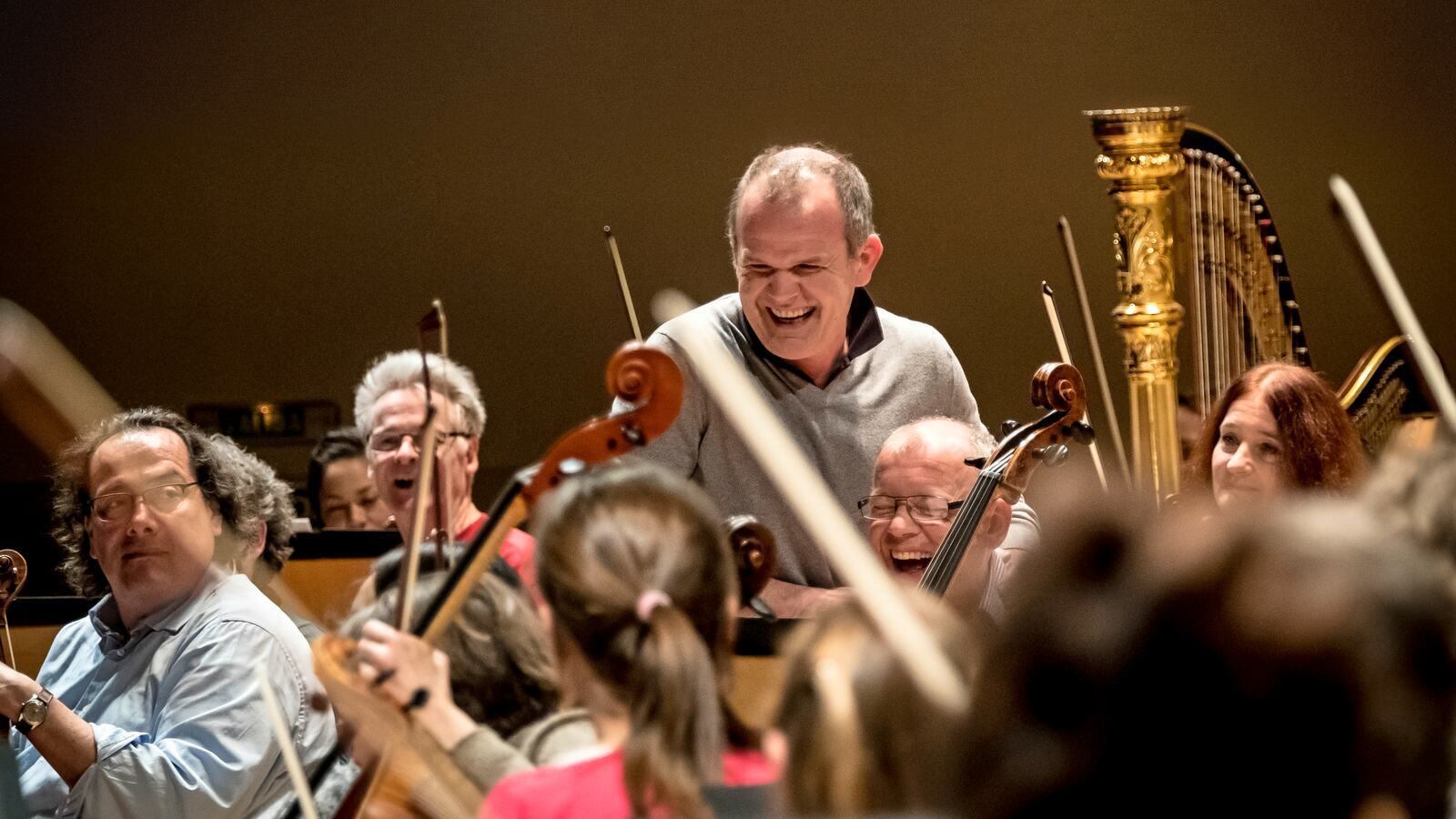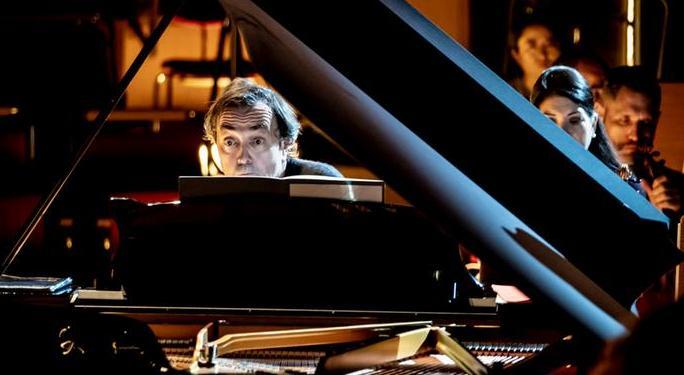In Beethoven anniversary year, there are three ways to enhance our ongoing concert dialogues with the composer beyond the bog-standard overture-concerto-symphony format: complete cycles of the quartets, symphonies and sonatas, preferably without old vulgarians presenting; focusing on Beethoven and his contemporaries, including programmes recreated from the early 1800s; and linking the genius with what our own contemporaries have to say about him.
By making its own unique tribute to the whopping "academies" the composer presented, not least in the 1808 blockbuster which included the premieres of the Fifth and Sixth Symphonies, interlacing the familiar with the shock of the new and placing a charismatic pianist at the centre, as happened with Beethoven himself, this very singular visit from the iconoclastic François-Xavier Roth and Cologne's oldest orchestra - its Philharmonie is also fortunate to play host to the NDR Symphony Orchestra - ticked the second and third boxes with aplomb.
 Not quite as long as the 1808 extravaganza, this was still a pack-everything-in event, sometimes challenging to the point of perversity. Not so the first half, where the Fifth, “Emperor” Concerto was flanked by the air and humour it lacks. Roth had brought in a choreographer, Jörg Weinöhl, to make the players “act”, and an award-winning German composer, Isabel Mundry (pictured right), to provide a soundscape, around Pierre-Laurent Aimard’s selection of four tiny Bagatelles from 1920. The aftermath, Roth holding down the last chord of the concerto with a slight fade for a silent segue, was a hoot: Francesco Filidei’s Quasi una bagatella, a comic battleground for pianist and orchestra to jab or propose to each other before rushing into helter-skelter combat with the inevitable “Emperor” quotation melted into the mix. Like so many musical jokes, it was slightly over-extended, but brilliantly executed.
Not quite as long as the 1808 extravaganza, this was still a pack-everything-in event, sometimes challenging to the point of perversity. Not so the first half, where the Fifth, “Emperor” Concerto was flanked by the air and humour it lacks. Roth had brought in a choreographer, Jörg Weinöhl, to make the players “act”, and an award-winning German composer, Isabel Mundry (pictured right), to provide a soundscape, around Pierre-Laurent Aimard’s selection of four tiny Bagatelles from 1920. The aftermath, Roth holding down the last chord of the concerto with a slight fade for a silent segue, was a hoot: Francesco Filidei’s Quasi una bagatella, a comic battleground for pianist and orchestra to jab or propose to each other before rushing into helter-skelter combat with the inevitable “Emperor” quotation melted into the mix. Like so many musical jokes, it was slightly over-extended, but brilliantly executed.
Aimard is always fascinating in his hyper-nuanced articulation, which goes a long way to offset what for me is a less than interesting piano sound; no-one wanted grandeur in the concerto, but a high sheen would have been good. The real novelties came in the orchestra, especially in the violas’ inititally ghostly little turn crescendoing into the first-movement recap. None of this solved my personal blind-spot with this work and especially its over-long finale, along with the Third Piano Concerto and the second and fourth movements of the Fifth Symphony; but I’m not alone – Glenn Gould also had a problem with middle-period Beethoven.
Part Two was more wayward and bolder with lighting – moonlight for That Sonata Movement, again offset by Mundryana, and a suggestion of the Yves Klein ultramine which inspired Zimmermann’s ever-astounding Photoptosis. The path to that was long and curious. The “Moonlight” faded into the somehow coherent jabs and chord-colours of Lachenmann’s Tableau. Paul Griffiths' observation in the programme - "Lachenmann paints with sounds, has them act and resist" - seemed at first uncharacteritically loose: doesn't every composer?. But if you thought about it, no, not every composer succeeds, and Beethoven was supreme in that; again, only connect. Tableau in turn resonated with the opening chordal try-outs of Beethoven’s First Symphony. Of which we got, bizarrely, only the first-movement exposition, albeit repeated, with plenty of gutty bite from the strings but not quite the fine-tuning of the performance from Nicholas Collon and the Aurora Orchestra the other weekend.  Plunging from C to its relative minor with the Allegretto of the Seventh Symphony, Roth (pictured above with some of his players) legatoed the later woodwind phrases to set up the Arietta (back to C) of the Op. 111 sonata; again, I’d have liked a bit more heavenly shine to Aimard’s sound, but his phrasing was, as before, keen and individual. We never got to the end; a trill melted into the start of Photoptosis. Its sonic frenzies felt especially ambivalent in the light of the recent German horror, the twilight of quotations (a collapse initiated by Beethoven’s Ninth-Symphony angry gesture of dismissal to spotlight Scriabin) fumbling for meaning before the final, virtuosic apocalypse, The Rite of Spring on, rather than in, ecstasy.
Plunging from C to its relative minor with the Allegretto of the Seventh Symphony, Roth (pictured above with some of his players) legatoed the later woodwind phrases to set up the Arietta (back to C) of the Op. 111 sonata; again, I’d have liked a bit more heavenly shine to Aimard’s sound, but his phrasing was, as before, keen and individual. We never got to the end; a trill melted into the start of Photoptosis. Its sonic frenzies felt especially ambivalent in the light of the recent German horror, the twilight of quotations (a collapse initiated by Beethoven’s Ninth-Symphony angry gesture of dismissal to spotlight Scriabin) fumbling for meaning before the final, virtuosic apocalypse, The Rite of Spring on, rather than in, ecstasy.
Interesting that Zimmermann subtitlted the work “Prélude”; it was so refreshing, alongside everything else in this astonishing evening, that Photoptosis moved from the usual “parking-lot” spot at the beginning of the programme to the end. So much to go away and think about, but also quite enough to feel in the moment. The wild enthusiasm at the end came from an ideally mixed audience; the Southbank is clearly doing something right in bringing new listeners to an experience which is so much more than just "classical". And please note the European/international credentials: French pianist and conductor working with an orchestra of all nations, German only strictly in name, including a British principal oboist (Tom Owen), and on German and Italian works. The free movement so conspicuous on every level in this happening must continue.














Add comment